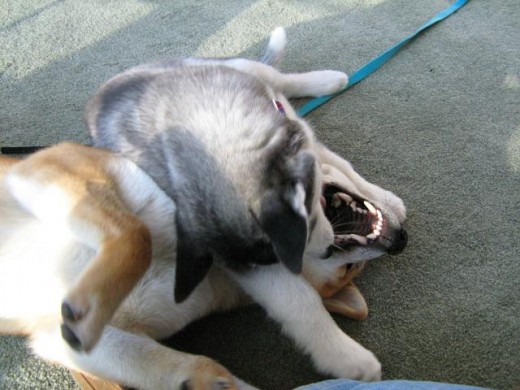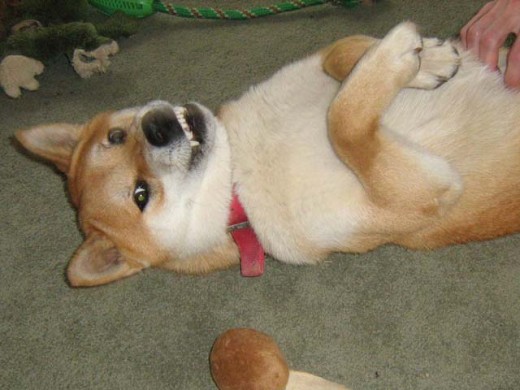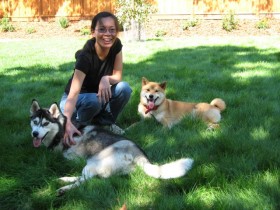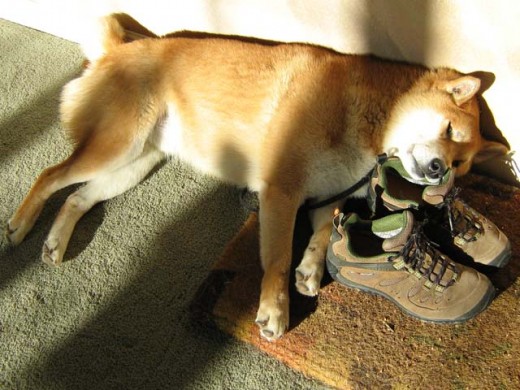Why do puppies bite?
Unlike us, puppies do not have opposable thumbs, so they manipulate stuff with their mouths, in the same way that we manipulate stuff with our hands. New puppies or young dogs will try to put everything into their mouths, because they are curious about objects and their surroundings.
Therefore, puppy biting is normal canine behavior.
Puppies also play with each other through play-biting. When a puppy bites too hard during play, his siblings may yelp and stop interacting for a short duration. Biting too hard on an adult dog (e.g. their mother), may also result in an undesirable consequence. In this way, puppies learn social rules and boundaries.

There is nothing wrong with dogs or puppies biting each other during play, but it is crucial to teach them to be careful with their mouths when interacting with people.
A puppy who is not taught this lesson, may become a danger to all the people around him, including his owners. Play-biting with humans, especially seniors and children, may cause accidental injuries and ultimately result in forced euthanasia.
If our puppy is biting us or others in an uncontrolled way, it is best for everyone not to engage in rough play with him. Also, do not play games that encourage biting such as Tug-of-War.

How to Deal with Puppy Biting
I deal with puppy biting by training my dog in three important areas –
1. Bite inhibition training
People have thinner and more sensitive skins than dogs do. Therefore, one of the first things that I teach my puppy is to control the force of his bites, especially when interacting with me and others.
2. Redirection and no-bite conditioning
When my dog bites on people, clothing, or unsanctioned objects (e.g. books, wires), I no-mark to let him know that it is an undesirable behavior. Then, I redirect his mouth onto something acceptable, and reward him for doing the right thing. In this way, he learns which objects are off-limits, as well as what he should do instead.
3. Excitement and self-control
An over-excited puppy, who lacks self-control, will tend to bite more often and with greater force. By managing my puppy’s excitement level and teaching him to control his impulses, I set him up for success, and reduce the number of instances where he engages in bad biting behavior.
An ounce of prevention is worth a pound of cure.
~~[Benjamin Franklin]
When dealing with puppy biting issues, I always try to stay calm but firm. I do my best to catch problems early on, and fix them before they escalate in degree and frequency.
If a dog is causing puncture wounds, or escalating his aggressive biting behavior, it is best to get professional help as soon as possible.
In this article, I discuss bite inhibition training and no-bite conditioning. For more on managing a puppy’s excitement level, please refer to Managing Puppy Excitement and Self-Control.
Bite Inhibition


Some dogs may have low bite thresholds. This means that they resort to biting or aggression even with fairly low, seemingly harmless stimuli.
One of my dogs, a Shiba Inu, can get mouthy when he is excited or frustrated, when I restrain him, when I stop him from doing something, and much more. Because of this, it is extremely important to train him to have good bite inhibition.
I start bite inhibition exercises as soon as I bring a puppy home. Even though puppy teeth are sharp, a puppy does not have the jaw strength of an adult, and is not capable of doing as much damage. Once my puppy has a soft mouth, I train him to stop biting on people.
Hand-feeding is a good way to teach our puppies to control the force of their bites. I hand-feed my puppy at least some of his kibble every day. If he bites too hard when getting his food, I do a sharp ouch or yelp, and ignore him for a few seconds. This teaches him that if he bites too hard, the food stops.
If my puppy is taking food from me gently, I praise him and keep the food coming. Often, I will combine hand-feeding with puppy obedience training and dog grooming sessions. Hand-feeding can also help prevent food aggression issues, so I continue this practice throughout my dog’s life.
We can also get Ian Dunbar’s book After You Get Your Puppy, for an overview of bite inhibition training.
Initially, Dunbar may come across as somewhat alarmist. We may feel that if we do not meet his somewhat unrealistic dog socialization and puppy training demands, things are going to go badly. I just try to ignore the alarmist talk, and focus on the bite inhibition and handling exercises, which are quite useful.
I am very thankful that my puppy (now adult dog) has a soft mouth. Because my Shiba Inu has good bite inhibition, we were able to solve many of his subsequent issues, which would have been difficult to deal with if he were biting at full strength.

When Our Puppy Bites …
When our puppy bites, it is important NOT to jerk our hand away. If we jerk away, we will likely get scratched. In addition, sudden and quick movements may make our puppy think that it is a fun game. This rewards the biting behavior, and encourages him to bite on us even more.
In the worst case, quick movements can activate a dog’s prey drive, and encourage aggressive behaviors. Therefore, it is important to control this reflex action, and stay still. In addition, I give a no-mark or yelp as a puppy might do to his litter-mates, when they are playing too rough.
I usually yelp when it is an accidental dog bite, for example when my dog gets his teeth on me while taking food out of my hand. Yelping is also appropriate for puppies that are still learning the rules. Otherwise, I use No for adult and adolescent dogs, who should know better.
After the no-mark, I always follow-up with a positive command, e.g. redirect him onto a toy.

1. Redirect Our Puppy onto a Toy

This technique is especially useful for an untrained puppy. It lets him know that it is ok to bite on a toy, but not ok to bite on people.
For example, my dog gets excited and starts biting when I scratch his tummy. Therefore, I used that as a training exercise to get him to bite on a toy, instead of on my hand. Since I can start the exercise anytime I want, I control the environment and make sure that I have multiple soft toys nearby for use. I make sure to reward my dog very well with food and affection when he redirects, so that I further reinforce the behavior.
A toy can also be useful for those cases where the puppy is losing control, and getting a bit too excited or frustrated. Giving him something to redirect his excitement or frustration at, may help to calm him down.
If I do not have a toy handy, I can also redirect by giving my puppy an alternate and simple command that he knows very well, e.g. Sit.

2. Withdraw Attention and Affection
Often, a puppy starts to bite at us because he wants to play or interact. Therefore, if my puppy does not respond to my redirect, then I withdraw my attention and affection. I do this by standing up, folding up my arms, and ignoring him. I make sure not to give any eye contact, not to talk, and not to engage him in any other way.
This is also called a timeout lite.
By doing this, my puppy learns that-
Out of control biting and jumping = No play, no attention, and no affection,
Gentle interaction = Play continues, food rewards, and extra attention.
Sometimes, my puppy may get too excited and escalate his behavior by biting on feet, or jumping and trying to bite on clothing. This is something that I absolutely do not allow because it can be very dangerous, especially with children and the elderly.
If my puppy escalates his behavior, I no-mark, say “Timeout”, and take him to a low stimulus timeout area immediately.
NOTE – In general, I try to set my dog up for success by managing his excitement level. In this way, I keep timeout-necessary episodes to a minimum.
3. Timeout

Most dogs value their freedom to roam around the house and backyard. Dogs are also pack animals, and like being with both human and canine members of the family. Since a timeout takes away both of these things, it is an extremely effective method of dog discipline.
When giving my dog a timeout –
- I make sure to put him in a really boring room, with no windows that he can reach. Currently, my dog’s timeout area is the laundry room.
- I check that the room is safe, and contains nothing that he can chew, play, or interact with in any way.
- Finally, I ensure that nobody gives puppy any attention during his timeout period.
It is better not to use a crate for timeouts. Crates are useful for transportation, management, and more. Therefore, I ensure that the crate is a happy place, where my dog feels comfortable going to for some peace and quiet, for sleep, and to chew on his favorite toy.
I find that a timeout is the most effective way to stop my dogs from biting. However, I only use it when my puppy is deliberately acting out, and not for accidental bites.
Initially, I start with a short 1 minute timeout. If my dog continues to bite right after he comes out, I return him to the laundry room for a much longer period of time (about 15 minutes). Be flexible with the timeout duration, and adjust it according to our dog’s age, temperament, and behavior. Some trainers do not believe in long timeouts, while others may ignore their dogs (timeout lite) for hours.
Do not use timeouts for training mistakes or lack of motivation.

How to Stop Puppy Biting
Some trainers suggest using aversive techniques to stop dog biting. For example, one suggested making my hand into a fist (so my fingers are safe), and then pushing my fist gently in when my puppy bites. This is uncomfortable for the puppy, and he will likely release our hand.
While it did get my puppy to release my hand, it did not reduce his biting behavior. In fact, my dog responds badly to any aversive methods. Doing this made him want to bite on me even more, because he got a reaction, and now has something (my fist) to fight with.
The same thing occurred with spraying water on his muzzle; he just started attacking the water bottle.
Ultimately, aversive techniques were not very effective with my dog, and caused even more behavioral issues. With aversive methods, it is difficult to trick a puppy into thinking that the bad stimulus is not coming from us. This can compromise a puppy’s trust and weaken our bond with him.
Instead, when my puppy bites,
- I first use a no-mark, for example, No or Ack-Ack to let him know that it is an undesirable behavior.
- Then, I redirect him onto a toy or give him an alternate command, for example Sit. If he stops biting and follows the command, then I praise him and reward him with attention and a fun game.
- If he continues to bite, I start with a timeout-lite by first withdrawing my attention. I do this by standing up, folding my arms, and turning away from him.
- If he escalates his behavior and starts to jump or bite on my clothing, then I quickly remove him to his full timeout area.
I always try to set my dog up for success by managing his excitement level. When he starts biting, I try to redirect and turn things into a positive learning experience. I only escalate my response when I absolutely have to, and I try my best to minimize those instances.

Hi, i recently read your article and applied the lesson to my 8 weeks old Labrador cross Sharpei puppy, but it seems like nothing is working. She is naturally aggressive when playing and when i tell her no, she does not back away until i gentle push her away cause it hurts. Then she gets into a attack state of mind and keep coming back to bite . I have had many dog experience from my past dogs (staffy) and i don’t seem to know what i am doing wrong . please help, we got a 2 year old nephew who really wants to play with her .
What type of training exercises have you tried? What was your puppy’s response? What is your puppy’s daily routine? Please note that saying no and pushing a puppy away is *not* what I do.
I do not physically engage with my puppy when I want to stop him from biting. Pushing my dog away or moving around a lot will only encourage my puppy to play and bite more. If I need to control my puppy, I use a leash. When my puppy is in training, I put a drag lead on him and I use that to control him if necessary. However, I only use a drag-lead under close supervision and I use a regular flat collar or harness. Absolutely no aversive collars.
More on how I use a drag lead and how I teach my puppy self-control.
I describe all the things that I do with my puppy in the article above. However, as you probably know, dog behavior is very context dependent so each dog and situation are different. When in doubt, I get help from a good professional trainer. In fact, when it comes to children and dogs, it is best and safest to get guidance from a good professional on how to teach both the child and the dog to interact positively and safely.
https://www.aspca.org/pet-care/virtual-pet-behaviorist/finding-professional-help
http://www.apdt.com.au/trainers-directory/how-to-choose-a-trainer.html
hi, i have 10 weeks old shiba inu. i have had him for 2 weeks. i know that shiba is very special race so i decide to ask for your help. i read your article about biting and i apply it. however, Nero is very stubborn, and when i do something he doesn´t like he start biting and make furios noises. for example when i take him inside from the garden. i dont want to use physical punishments, but i want to have a little bit respect. what should i do ? thank you for your answer
What exactly did you try? What was his exact response to each of these things? What is his daily routine like? What type of training is he used to? What management equipment are you using?
Dog behavior is very context dependent, so details of what we did, how our dog responds, his environment, routine, and more are all very important. This is why when in doubt, I get help from a good professional trainer. A good trainer can meet with my dog, see his temperament, and observe his behavior within the context of his regular environment and routine. Timing and consistency are also very important, and those are things that a trainer also helped me with.
https://www.aspca.org/pet-care/virtual-pet-behaviorist/finding-professional-help
help…
my puppy does not play with my old dog he thinks that my old dog want to bite him and starts crying but my older dog just wants to play
How I introduce a new dog to my existing dogs.
Hi, i have a 12 week old pit/boxer mix female puppy, when shes sleeping and my 2 Yr old grandaughter wakes her..she growls and nips.what can i do to stop this behavior? Is she being aggressive? Should i find her a new home without young children..im worried that this will stick with her as she ages and may hurt one of my grandchildren if i dont or cant correct this behavior.please help.
Some dogs may instinctually snap when *startled awake*. This is a defensive response because a dog is more vulnerable when asleep, and may be disoriented when awoken suddenly, especially from a deep sleep. This is probably where the saying “let sleeping dogs lie” originates from.
One time, my Shiba Inu was sleeping by my feet and I reached down to stroke him. He got startled awake, and air-snapped close to my hand. Now, I always make some noise first, and wait until he is properly awake before I physically interact with him.
Young puppies also need training on self-control, bite inhibition training, how to properly interact with people, etc. I set up a consistent set of rules for my dog and a fixed routine. Similarly, I also set up rules for people who meet my dog so that they do so properly, and in a positive and safe way. I manage my dog carefully, set him up for success, and I make sure everyone in the house understands how to safely interact with him.
Given that you have very young children about, it is best to get help from a good professional trainer. Proper management and prevention are key when training my puppy.
https://www.aspca.org/pet-care/virtual-pet-behaviorist/finding-professional-help
https://apdt.com/pet-owners/choosing-a-trainer/
I have 6 month old Belgian malinois German shepherd mix he tries to grab on to my cloths or anything part of my with his mouth when I walk away when he on a leash tied on something like a tree. He only does it when he gets very excited. Also when we pet him on the head when he gets really excited he play bites and it gets really annoying How do I stop him from doing those behaviors?
More on how I manage my puppy’s excitement and teach him self-control.
What I do when my puppy bites on me.
I talk more about my experiences in the article above.
Hi, your site is vey informative and helpful. I have a 7 month old mix of norwegian elkhound, finnish hound and bearded collie. The last weeks she started biting on my arms especially, she turns around and jumps up and bite while we are out walking. Especially at the end of the walk, and often at the same place… She stops after a while when I timeout and ignore her, but she bites quite hard now… How can I work better with her so this stops completely ?
My Shiba Inu, Sephy, used to do some crazy leash biting. Here is more on our leash biting experiences. Luckily, I did a lot of bite inhibition exercises with him when he was young, so he never really broke skin.
Some other things that helped with Sephy is to put more structure around and during the walk.
However, dog behavior is very context dependent so each dog and situation are different. During Sephy’s difficult period, it was helpful to consult with good professional trainers who could observe Sephy’s behavior within the context of his routine and environment.
http://www.aspca.org/pet-care/virtual-pet-behaviorist/finding-professional-help
https://apdt.com/pet-owners/choosing-a-trainer/
Thank you for the helpful answer and articles ! I live in a place where there is more moose than traffic and people :). So my Tuva has alot of nature and space for herself, and we hike alot. It seems like it does not matter how long or short and frequent the walks are, when she sees the house and know its time to finish the walk she starts this behavior. Today I tried several short walks, on the way from the house we take it easy and train during the walk and it seems to work out fine as it does most of the time, on the way back she turns around and start to jump and bite .. When i ‘no’ her in other situations she understands ‘no’ and stops, but in this it’s like she going completely ‘out of her mind’ .. if you know what I mean 🙂
Very helpful I have 2 jack Russell / parson Russel cross puppies 6 wks old in couple of daysthey chew each others ears & tails til the other yelps quite loud obviously in pain iv tried to intervene but the attacking puppy grips tighter so cannot pull them off for danger of ripping the ear or whatever they locked on 2 at the time. I will try your method. …wish me luck
What I have noticed with my dogs is that they get more rough during play when they are over-excited. Therefore, I can dampen their roughness by managing their excitement level with frequent play-breaks.
More on how I do play-breaks.
I just got a 3 year old Pomeranian dog, had him 1 week and ever since getting him he keeps biting, whenever he is excited(getting his lead to go on a walk) or when (taking his lead of)… Really need help as before getting him because he was moved around a lot and don’t want to get rid of him. Thanks
What I do when my puppy bites on me.
http://shibashake.com/dog/how-i-trained-my-husky-puppy#bite-training
I talk more about time-outs and redirection in the article above. I also do bite inhibition training with all of my dogs.
I set up clear boundaries, a fixed routine, and a consistent set of rules for my dogs. This creates certainty, reduces stress, and helps them to stay more calm/relaxed. More on what I do with my dogs.
My 4 month old German Shepherd boy is such a sweet puppy 80% of the time. We find that 1 or 2 times a day he is a beast. He jumps and nips on us while constantly biting. My husband and I are nearing our wits end. I have to believe that teething or something is making this happen. Usually around breakfast time and dinner time we have noticed. Where would you think we should start in fixing this behavior. We go on long walks/run right after breakfast and soon after dinner. I feel like he is getting lots of exercise. do some dogs need more? Our other shepherds never acted like this.
-very frustrated 3rd time owners of a German shepherd dogs.
Frozen Kongs were really helpful in terms of keeping my Husky puppy occupied when she was young. I also follow the Nothing in Life is Free program with all of my dogs, so they work for all of their food. That seems to be a good way for them to expend some of their energy in a positive way.
Based on what I have read, dogs are crepuscular so they tend to be most active at dawn and dusk. My adult dogs are less hyper and are more in control of their impulses, so they are usually ok. However, my youngest Husky Lara, sometimes just needs to do zoomies to get her energy out. We also walk her early in the morning (before 7am) every other day.
More on what I do when Lara jumps and bites on me.
Hi
i have a 10 week old siberian husky and a 3 year old german shepherd X labrador, they both love to play with each other but my husky bites way too hard for my other dog and hurts him, how do i stop this??
What I do when introducing a new puppy to my adult dogs.